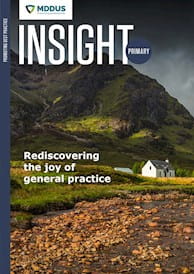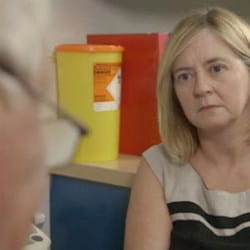BACKGROUND
A 13-year-old-boy attends a GP surgery with his mother, complaining of a sore ankle. Marcus says he sprained it nearly three weeks ago playing football after school and the ankle is still painful.
Dr G carries out an examination and notes: Left ankle sprain, three weeks. Uncomfortable with slight swelling but improving. No apparent bone injury.
The GP prescribes a tubigrip bandage and instructs Marcus and his mother to return if there is no improvement.
Three weeks later Marcus is brought to A&E by his mother, still complaining of persistent ankle pain. A specialist registrar in emergency medicine conducts an examination and records: Football injury six weeks ago, awkward tackle. Saw GP, diagnosis sprain. On exam: swollen left ankle. Tenderness over malleolus. Restricted movement in all directions. Foot deviated laterally at rest/walking.
An X-ray is taken and shows a comminuted fracture of the distal fibula, with rotation and lateral displacement of the distal fragment.
An appointment is arranged at the orthopaedic clinic and a consultant surgeon undertakes an open reduction of the fracture two weeks later. The wound heals well and Marcus is placed in a walking cast for six weeks. Subsequent X-rays show the fracture has healed well.
Six months later Dr G receives a letter from solicitors acting for Marcus claiming failure to diagnose the ankle fracture and refer for X-ray. It is alleged that this resulted in an unnecessary and more complex operation and a longer recovery with potential for later complications.
ANALYSIS/OUTCOME
An MDDUS medico-legal adviser acting on behalf of Dr G reviews the case and commissions expert reports from a GP and a consultant orthopaedic surgeon.
The GP expert observes that the record from the initial consultation is minimal. There is no note of the mechanism of the injury. No observations are included on the patient’s inability to weight-bear after the injury. Marcus’ mother also disputes informing Dr G that the symptoms were improving and states the reason that they attended was because of the persistent pain.
Dr G claims he carried out a full examination but the patient notes offer no specific details on the nature of that examination.
The GP expert also observes that findings recorded later by the emergency doctor are highly likely to have been present when Marcus was seen by Dr G. The expert cites the Ottawa Ankle Rules to determine the need for a radiograph in acute ankle injuries and concludes that had these been applied appropriately Marcus would have been referred for an X-ray – given his inability to weight-bear immediately after the injury and the presence of bony tenderness. In his opinion this constitutes a breach of duty of care.
The orthopaedic surgeon offers a view on causation (whether there was harm as a consequence of the breach of duty of care). He observes there was a three-week gap between the injury and Marcus attending the GP surgery. Another three weeks elapsed before a definitive diagnosis was made at hospital.
The expert states that the outcome in such a case would certainly be worse after a delay of three weeks than with surgical treatment undertaken in the first few days. However, he concludes that the further delay of three weeks (before Marcus presented at A&E) is unlikely to have dramatically influenced the outcome or prognosis.
A letter of response is drafted by MDDUS lawyers on behalf of Dr G, denying clinical liability based on a lack of proven causation. The case is subsequently dropped.
KEY POINTS
- Ensure you follow established guidelines when assessing sprains or other limb injuries.
- Comprehensive patient notes including relevant history and examination findings (particularly if using guidelines) are essential to legal defence.
- To establish liability both breach of duty of care and causation must be proved.
This page was correct at the time of publication. Any guidance is intended as general guidance for members only. If you are a member and need specific advice relating to your own circumstances, please contact one of our advisers.
Read more from this issue of Insight Primary

Save this article
Save this article to a list of favourite articles which members can access in their account.
Save to library



